Lewis Powell was just 21 years old when he conspired with John Wilkes Booth and several others to plot the assassinations of Abraham Lincoln, Andrew Johnson, and William Seward in an effort to topple the U.S. government.
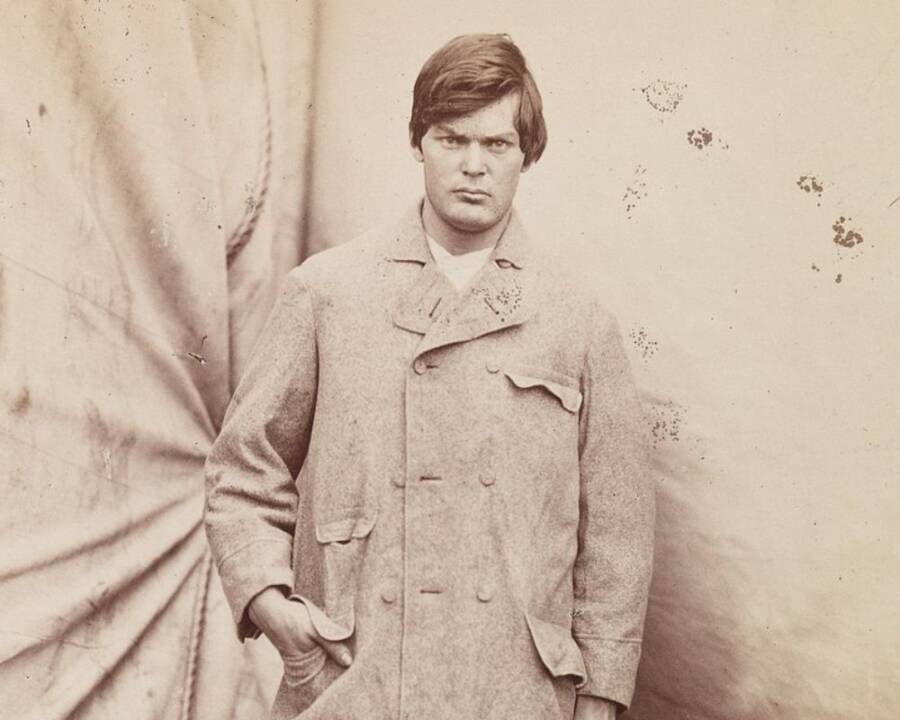
Wikimedia CommonsThe Civil War and the staunch political divides it caused likely convinced Lewis Powell to join John Wilkes Booth in the assassination plot against President Abraham Lincoln.
Lewis Thornton Powell, also known as Lewis Payne, was hanged in Washington, D.C., in 1865 for collaborating with John Wilkes Booth in the assassination of President Abraham Lincoln. While Booth’s actions have gone down in history, Powell’s contributions to the plot aren’t nearly as well-known.
For one thing, Lincoln’s assassination was part of a much larger endeavor than the murder of one man. Conspirators also planned to murder Vice President Andrew Johnson and Secretary of State William H. Seward that day on April 14, 1865.
According to the Washington Post, Powell was tasked with killing Seward. He nearly succeeded, too, when he all but stabbed Seward to death in his own bed just as gunfire erupted in Ford’s Theatre.
But before his blood-lusty run at the nation’s leaders, Powell was just the tender Southern son of a Baptist minister. So how, exactly, did this gentle farmer-turned-soldier come to so disrupt his country at the cost of his own freedom — and life?
From Farm Boy To Soldier: Inside Lewis Powell’s Life Before John Wilkes Booth
Would-be assassin Lewis Powell was born in Randolph County, Alabama, in 1844 to a Baptist minister named George Cader Powell and his wife, Patience Caroline. He was raised in Georgia with his siblings, who remembered him as a “sweet, lovable, kind young boy.” They called him “Doc” because he enjoyed caring for sick animals on their farm.

Wikimedia CommonsPhotographer Alexander Gardner was permitted to photograph Powell in the same coat and hat he wore the night of Secretary Seward’s attack.
Powell was bookish, and he was initially keen on following in his father’s religious footsteps. But the Civil War had other plans for him.
According to the University of Missouri – Kansas City, Powell was desperate to enlist in the Confederate Army when the war broke out in 1861. He was just 17, but he lied about his age and joined the 2nd Florida Infantry Regiment.
By the time he was 20, Powell had participated in several major campaigns. Most notable were the Siege of Yorktown and the Battle of Williamsburg.
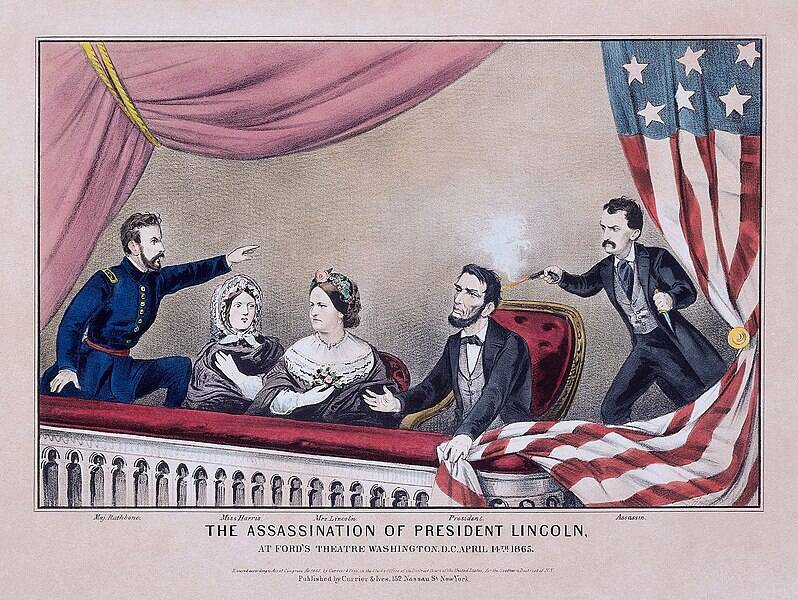
Wikimedia CommonsAt the close of the Civil War, 21-year-old Powell was arrested for the attempted murder of Secretary of State William H. Seward.
Fellow servicemen recalled how Powell was “chivalrous, generous, and gallant” and “always keyed up for battle.” However, he also earned himself the nickname “Lewis the Terrible” for his prowess in combat.
But in 1863, Powell was injured at the Battle of Gettysburg and captured by Union troops. While hospitalized, he met a young nurse named Margaret Branson, with whom he developed a relationship. She likely helped him to escape, and some accounts even allege that she smuggled him a Union Army uniform.
Powell then joined up with Mosby’s Rangers, a notorious Confederate battalion that terrorized the Union Army by disrupting communications and supply lines. It was during his time with the Rangers that Powell likely became involved with the Confederate Secret Service — and ultimately with John Wilkes Booth.
Lewis Powell’s Connection To John Wilkes Booth
Lewis Powell deserted Mosby’s Rangers in January 1865, claimed he was a civilian refugee, and signed an Oath of Allegiance to the Confederacy under the name Lewis Payne. He settled in a boarding house in Baltimore, where he began displaying violent tendencies.
Soon after arriving at the boarding house, Powell assaulted a Black maid. According to a witness, Powell “threw her on the ground and stamped on her body, struck her on the forehead, and said he would kill her.” Powell was arrested, but the charges against him were dropped when witnesses failed to appear in court.
Around the same time, Powell was introduced to John Surratt, a slippery co-conspirator of John Wilkes Booth. Surratt and other Confederate operatives then introduced Powell to Booth himself, a well known actor and the brother of actor Edwin Booth. The assassin was amassing loyal devotees for a plot to kidnap President Abraham Lincoln.
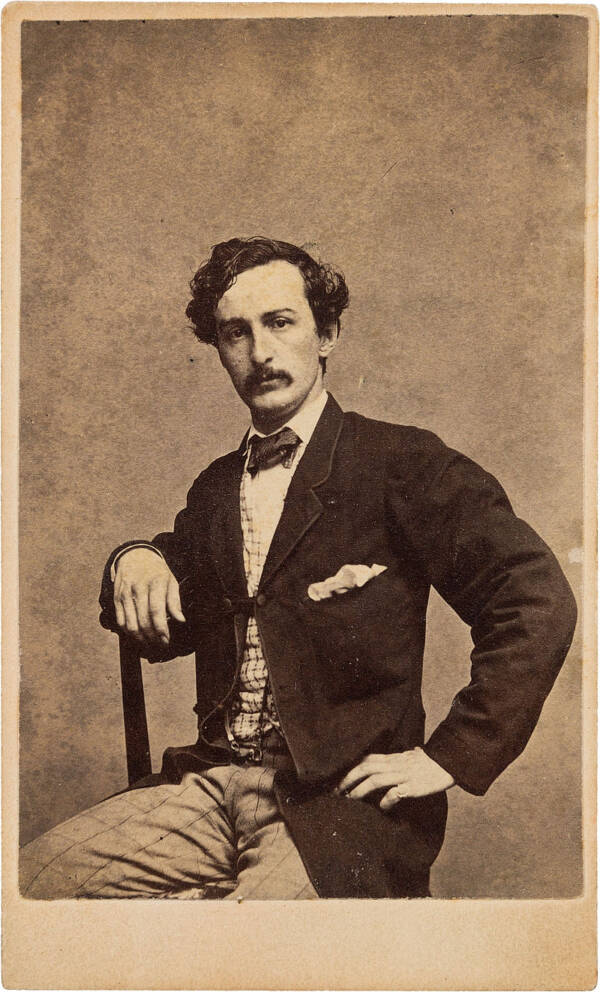
Wikimedia CommonsJohn Wilkes Booth was rounding up co-conspirators to kidnap the president and take him into Confederate territory across the Potomac River when he was introduced to Lewis Powell.
Booth’s plan was to ferry Lincoln across the Potomac River and into Confederate territory. From there, the South could make any number of demands in exchange for his release.
Of course, that never happened — but Booth’s more sinister alternative certainly did. By April 1865, the Civil War had come to an end. And Booth put his backup plan into action.
The Botched Assassination Of The Secretary Of State
It’s unclear exactly how and when Powell became entrenched in Booth’s assassination plot. However, Booth had nonetheless come to trust Powell enough that behind Surratt, he considered him the foremost co-conspirator in his new plan to murder Secretary of State William H. Seward, Vice President Andrew Johnson, and President Abraham Lincoln.
Powell would take care of Seward, co-conspirator George Atzerodt would see to Johnson, and Booth would assassinate Lincoln. Only Booth would succeed.
By all accounts, Powell’s assignment should have been easy enough. Seward was bedridden from a carriage accident he’d suffered nine days earlier and would likely pose little resistance. But Powell failed spectacularly and instead managed to wound eight people without killing Seward.
This included four of Seward’s children, a messenger, and a bodyguard.
Powell arrived at Seward’s home around 10:13 p.m. on April 14. According to CBS News, the New York Herald described Powell as “a tall, well-dressed man” who claimed to be delivering the secretary’s medicine. Powell’s co-conspirator, David Herold, waited outside.
When Powell was refused entry into the secretary’s home, however, all hell broke loose.
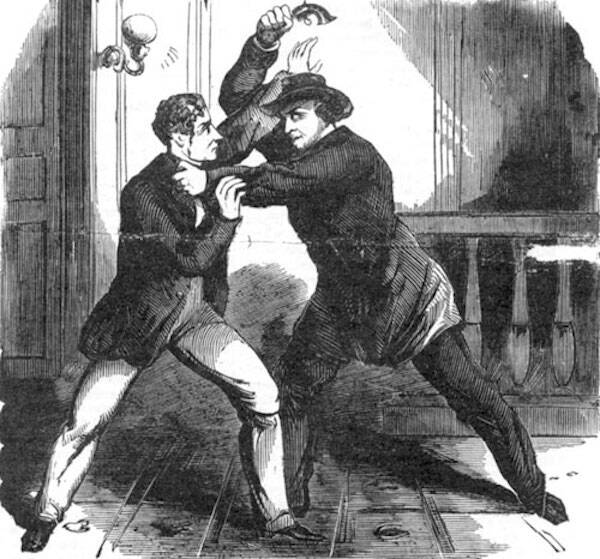
Wikimedia CommonsPowell’s gun misfired when he tried to shoot Assistant Secretary of State Frederick Seward. He pistol-whipped him instead before proceeding to his father’s bedroom. National Police Gazette, April 22, 1865.
Pushing past the servant who had answered the door, Powell bolted for the third floor and encountered Frederick Seward, the secretary’s son and Assistant Secretary of State. He tried to shoot him, but his gun misfired. Powell pistol-whipped him and fractured his skull instead.
By this point, Lincoln had already been fatally shot by Booth at Ford’s Theater while watching a play with his wife Mary and a couple named Clara Harris and Henry Rathbone.
With an inkling of what was happening at the theater, Powell then ran into Augustus Seward, yet another son of the secretary, whom he stabbed to advance farther down the hall. Finally, he made his way into William Seward’s bedroom.
Hearing the stark sounds of violence emanating from the house, Herold tied Powell’s horse to a tree and escaped on his own steed.
Bedridden, Seward had multiple people at his side: his bodyguard Sergeant George Robinson, a male nurse, and his daughter Fanny. Every one of them was caught by surprise and terribly injured.
After squabbling with Robinson and stabbing the male nurse in the lungs, Powell stabbed Seward in the neck and chest. However, he failed to strike a fatal blow, because Seward was wearing a splint following his accident that protected him from Powell’s knife. The victim’s eldest son, Major William Seward, Jr., rushed in and was met with a dagger in his side.

Wikimedia CommonsFour of the conspirators were sentenced to death, and the others were sentenced to life in prison. One co-conspirator received a six-year term, while John Wilkes Booth was shot to death in a barn in Virginia.
The room was splattered in blood, and Powell was convinced that he’d accomplished his task. He bolted for the exit, screaming, “I’m mad! I’m mad!”
It was one of the last moments of freedom Powell ever had.
The Arrest And Trial Of Lewis Powell
After aimlessly wandering the streets of Washington, Powell headed to the home of co-conspirator Mary Surratt, the mother of John Surratt, on April 17. It was the worst thing he could have done, as she was being questioned by police when he arrived. They were both arrested.
Everyone, including Seward, recovered from their injuries wrought by Powell. Andrew Johnson also survived because his assigned assassin, Atzerodt, decided to get drunk instead of murdering the vice president. Booth was the only conspirator who succeeded — but John Wilkes Booth was killed 12 days later by a Union soldier named Boston Corbett.
His co-conspirators would have to face trial.
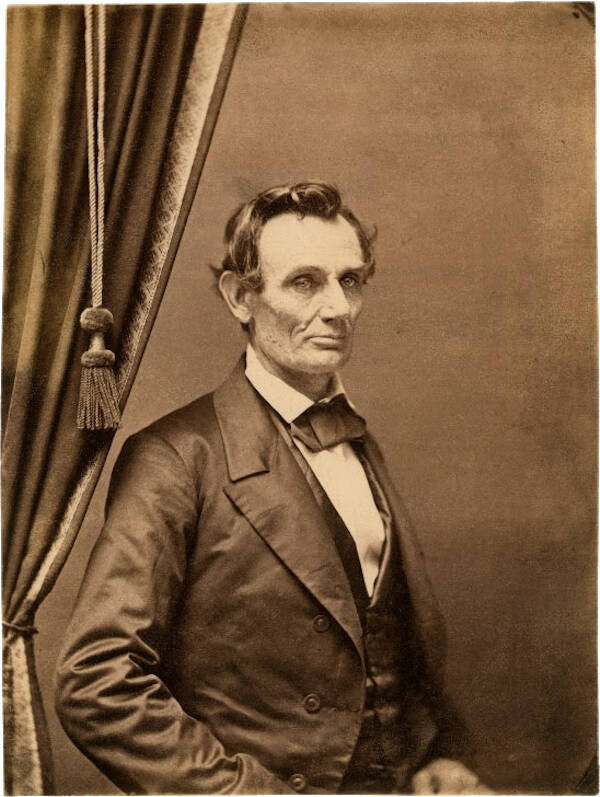
Wikimedia CommonsAbraham Lincoln died on April 15, 1865 after he was shot in the head by John Wilkes Booth while watching a play at Ford’s Theatre.
The six-week trial saw Powell surprisingly stoic and calm. Described as the “Mystery Man” and “Payne the Mysterious” in the papers, he never cracked under pressure. According to James L. Swanson and Daniel Weinberg’s Lincoln’s Assassins: Their Trial and Execution, reporter Benjamin Perley Poore described Powell as follows:
“Lewis Payne was the observed of all observers, as he sat motionless and imperturbed, defiantly returning each gaze at his remarkable face and person. He was very tall, with an athletic, gladiatorial frame; the tight knit shirt which was his upper garment disclosing the massive robustness of his animal manhood. Neither intellect nor intelligence was discernible in his unflinching dark gray eyes, low forehead, massive jaws, compressed full lips, small nose with large nostrils, and stolid, remorseless, expression.”
The 21-year-old was represented by former Washington provost marshal Colonel William E. Doster, whose defense was rooted in arguing for leniency since Powell’s victim didn’t die and attempting to garner sympathy by inaccurately describing Powell’s childhood.
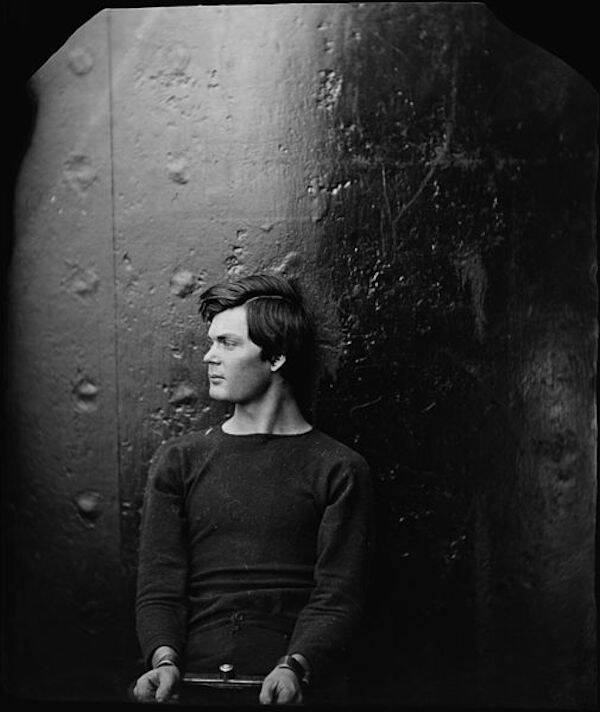
Wikimedia CommonsPowell was described as mysterious throughout the six-week trial, never showing any distress or sorrow for his situation.
It was all for naught, of course. Four of the conspirators — Lewis Powell, David Herold, Mary Surratt, and George Atzerodt (who failed to kill Vice President Johnson) — were sentenced to death by hanging.
Three others were sentenced to life in prison, while an eighth received a six-year term behind bars.
A Bungled Suicide, Death By Hanging, And Restless Afterlife
At one point following his arrest, Powell tried to kill himself by beating his head against his cell walls. He reportedly said that he was “tired of life” and would “rather be hung” than “come back into the courtroom.” He was then fitted with a padded hood. The government strictly prohibited the conspirators from having any visitors, though photographer Alexander Gardner was allowed entry.
“He was photographed… standing in various ways, with and without wrist irons and modeling the coat and hat that he allegedly wore the night he attacked Secretary of State Seward,” Swanson and Weinberg wrote.

Wikimedia CommonsThe conspirators weren’t permitted any visitors. Only photographer Alexander Gardner was allowed entry, taking several portraits of Powell.
On July 7, 1865, the time had come for Surratt, Atzerodt, Herold, and Powell to face justice for their crimes. Led to the gallows at Washington Arsenal in Washington, D.C., they had their heads covered in white bags and nooses tied around their necks.
After they were hanged, their bodies were buried in wooden gun crates outside the prison walls, with a small fence erected around the plot. In 1867, they were exhumed in secret and reinterred under the same warehouse beneath which Booth was buried.
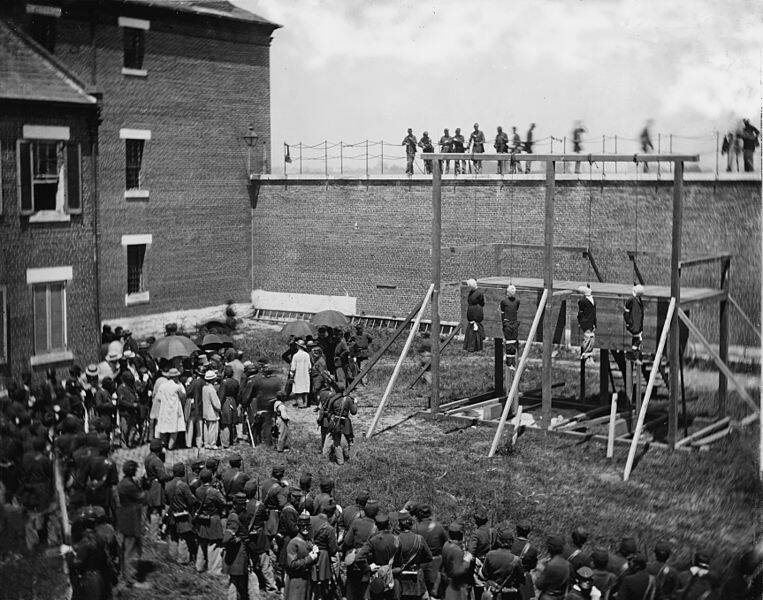
Wikimedia CommonsThe execution of Lewis Powell, Mary Surratt, David Herold, and George Atzerodt.
In 1869, all bodies except Powell’s were released to their families. A few years later, his corpse was exhumed again and buried in the Holmead Cemetery in Dupont Circle, Washington. It was exhumed yet again in 1884 as the cemetery prepared for closure.
In 1885, Powell’s skull was given to the U.S. Army Medical Museum, while the rest of his remains were buried in Washington’s Rock Creek Cemetery. Labeled as specimen number 2244, or “skull of a white male,” the museum gifted the cranium to the Smithsonian in 1898.
Nearly a century later, in 1992, the Smithsonian encountered specimen 2244 while assessing items for potential repatriation to Native American tribes. Two years later, according to the South Florida Sun Sentinel, Powell’s skull was returned to his family’s descendants.
Today, the skull of the gentle boy who somehow became involved in one of the most infamous assassinations in U.S. history is buried next to his mother in Geneva, Florida.
After learning about Lincoln assassination co-conspirator Lewis Powell, take a look at the photo of an 11th-generation Lincoln. Then, learn 33 interesting facts you never knew about Honest Abe.





